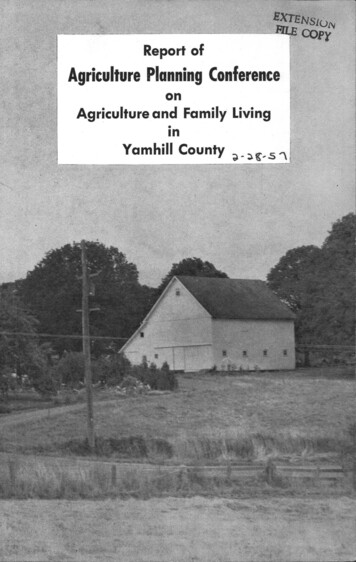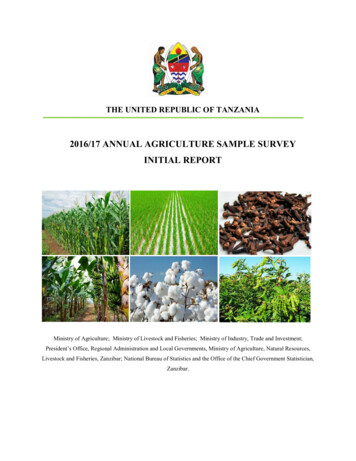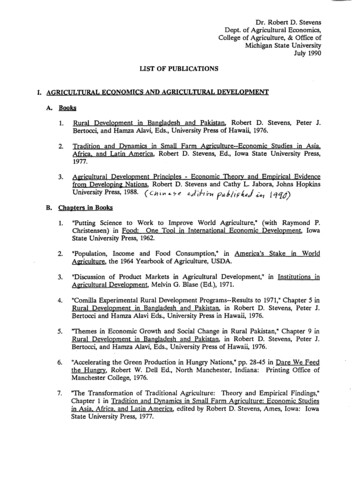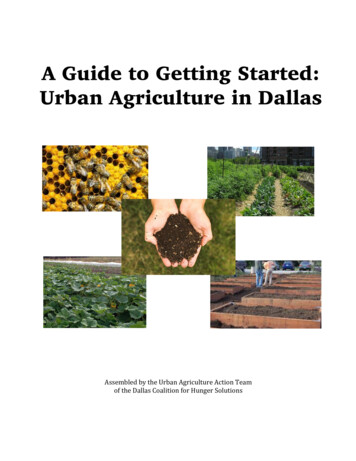
Transcription
EXTENSIReport ofAgriculture Planning ConferenceonAgriculture and Family LivingYamhill County
A "Foreword" for the Yamhill County ProgramPlanning ConferenceThis booklet reflects the thinking of the members of thirteen committees that delved into the future of Yamhill County Agriculture, andfarm and home living during the winter months of 1956 and 1957.These reports were presented at a county-wide conference on February 28, 1957. They were adopted at that conference which was a publicmeeting of interested citizens of Yamhill County.The Conference was sponsored by the Yamhill County AgriculturalPlanning Council.The purpose of the Conference was to bring up to date, thinkingon trends in farming and home living.We suggest the reader will find numerous facts regarding futureagricultral development possibilities and ideas for better living of bothcity and farm dwellers in this booklet.ROGER DUMDI,Chairman Yamhill CountyAgricultural Planning CouncilLOUIE H. GROSS,Yamhill County Extension Agentand Secretary of the Council-1--
MEMBERS OF YAMHILL COUNTY AGRICULTURALPLANNING COUNCILROGER DUMDI, Canton, ChairmanJ. P. JUNGWIRTH, NewbergREX BROWN, CantonNED PALMER, DaytonVICTOR SCOGGAN, DaytonWALLACE JOHNSON, YamhillLAURENCE SOHRWEID, McMinnvilleLOUIE GROSS, County ExtensionAgent, SecretaryWAYNE ROBERTS, County ExtensionAgentWILLIAM PERRY, County ExtensionAgentJANET IRVING, County ExtensionAgentALBERT YOUNGBERG, CountyLLOYD DtJMDI, CantonMRS. KENNETH SIMPSON, NewbergMRS. DON LANDAUER, NewbergMRS. SANFORD BROWN, McMinnvillePAUL FRITZ, McMirinvillePHILLIP HAWORTH, NewbengCommissioner2
GENERAL INFORMATION ABOUT YAMHILL COUNTYThe Physical BaseYamhill County lies west of the Willamette River in northwestern Oregon.It is irregularly shaped, its western halfforming a reversed L, the base of whichstretches to within 8 miles of the Pacificfrom 500 to 1,000 feet; the valley sectionof the county averages about 200. High-est elevations in the Chehalem Mountains and the Eola Hills are about 1,000Ocean. Greatest dimensions are 40 milesfeet.Farmers owned 272,000 acres or three-north to south; the total area is 454,000acres. McMinnville, the county seat andlargest town, is located on the Pacificland was distributed as follows: cropland, 135,000 acres; pasture land, 40,200; pastured woodland, 75,000; woodland and other land not used for agri-from east to west and 26 miles fromHighway 99W 38 miles southwest ofPortland. Newberg, second largest town,is situated 14 miles northeast of McMinuville on the Willamette River. Other towns are from north to south, Yamhill, Canton, Lafayette, Dayton, Amity,and then west to Sheridan and Willamina.Topography and ResourcesFrom thevalleys of the Willamette and YamhillRivers, the land rises in terraces androlling hills to meet the mountains ofthe Coast Range along the westernboundary and the Chehalem Mountainsto the north. About two-thirds of thecounty is mountainous or hilly. Thesoutheastern third is valley land exceptfor the Eola Hills, which separate theWillamette and Yamhill Valleys nearthe county's southern boundary. Themain divide of the Coast Range, withelevations ranging from 1,500 to 3,000feet, lies from 1 to 2 miles within thewestern boundary and closely parallelsit. East of the divide, elevations rangefifths of the total area in 1957. Thiscultural purposes, 25,000.ClimateMild temperatures, a fairlylong growing season, and a favorabledistribution of rainfall contribute tohigh crop and pasture yields. Temperatures at McMinnville vary from a January average minimum of 33 degreesto an August average maximum of 84degrees. The average growing season is174 days. These temperatures are characteristic of the eastern valley area.In the extreme southwestern end, thesummer heat is tempered by cool oceanbreezes which blow through a low passin the Coast Range.Average annual precipitation at McMinnville is 43 inches. Between midJune and early September there isusually a period of 50 to 60 days withpractically no rain, an ideal conditionfor harvesting seed crops and fruit.Snowfall at McMinnville averages 11inches annually, and the snow rarelyremains on the ground more than afew days at a time.School Situ ationYamhillCounty hassevenCollege of Education at Monmouth, andhighschools covering the county except fora small area served by the Gaston HighSchool in Washington County. Nearly2,100 students are enrolled.There are 34 grade schools in thecounty with about 5,500 pupils enrolled.Yamhill County has three collegesoffering advanced education. LinfieldCollege in McMinnville, a Baptist institution, is the largest with about 800enrolled. George Fox College, a FriendsChurch sponsored school, is in Newberg. A Society of Jesus (Catholic) Novitiate is located near Sheridan.Within 80 miles of Yamhill Countyare four state-supported schools ofhigher learning. They include OregonState College at Corvallis, Universityof Oregon at Eugene with its Dental andMedical branches in Portland, Oregon3Portland State College in Portland. Inaddition, there are about a dozen independent colleges and universities in thesame area.There are six parochial schools operating in the county. Four operate oneor two rooms, one has three rooms,and one has six rooms. In some cases,public school buses transport certainpupils to these schools. Most of the teachers are well prepared for their profession. A generous percentage have oneor more college degrees; the others withvery few exceptions meet the state requirements. The pay schedule for allteachers is rather favorable. Very fewreceive less than 3,700 per year for fulltime services; salaries range upwardto over 6,400 for class room teachers.Superintendents and principals are paidaccordingly.
Medical Servicesone Public Health Nurse, one clinicnurse, and one sanitarian.ty with 125 bed capacity. Twenty-sixSix nursing homes, are operated byphysicians are now practicing in 'Yamvarious groups and private individualshill County and there are 15 dentists.in Yamhill County. An infirmary isavailable to students at Linfield ColThe County Health Office operates witha staff of one County Health Officer,lege.There are three hospitals in the coun-Churc hesficulty in finding a church of its choiceYamhill County has many churcheswith most denominations being reprein or near any community.sented. A family will have little dif-Recreational Serviceswater, and fresh water fishing. ThereYamhill County offers many recreaare coastal and mountain lakes to thetional opportunities. The Willamette Riwest, and east which provide fishingver forms part of the eastern countyand water sport facilities.boundary. The Yamhill River, which hasThere is also hunting of deer, pheastwo forks, the North and South Yamants, and water fowl close by.hill Rivers, flows into the Willamette atMcMinnville has a new all-year-roundDayton. It is within easy driving disswimming pool, while Canton and Newtance of the Pacific Ocean with itsberg both have outside swimming poolsfor summer use.many scenic beauties and recreationalopportunities including deep sea, tideRoads and Tra nsportationThe general road situation for Yamhill County is good. One main stateYamhill County is one of the main trav-eled areas for Portland folks going tothe coast.The county is serviced by severalfreight lines, Southern Pacific Railroad,and the Pacific Greyhound buses.highway goes through the county northand south. Parts of this are now beingwidened into a four-lane highway. Also,Crops and IncomeThere are 2,473 farms in Yamhill 1,867,500; turkeys, eggs, and poults,County. The average-sized farm is 110.2acres, with an average value per acre of 213.14. 2,600,000 miscellaneous livestock, 50,000; cereal grains, 3,000,000; seed crops, 1,200,000; vegetables, 1,588,750; ber-follows: Beef and veal, 1,334,400; sheepand wool, 362,820; hogs, 200,000;dairy, 2,455,000; chickens and broilers,720.Farms marketings for 1956 were asries, 1,306,000; tree fruits, 1,000,000;nuts, 360,000; farm forestry, 400,000;miscellaneous, 500,000; total, 18,333,-Marketing FacilitiesMost of the livestock marketings areeither at the Portland Union Stockyards,Salem, or Hillsboro. All of these mark-of McMinnville has facilities for handling the milk in the area. Considerablemilk goes into Portland as fresh milk,and there are several processors in thecity of Portland as well as locally.ets are within easy trucking distance.The Farmers' Cooperative CreameryGrain War ehousesYamhill County is well supplied withreliable feed and seed dealers. Thesewarehouses have done a good job inthe past marketing specialty seed cropsfor growers in this area. This is provedby the dollar marketing of cereal grainsand the seed crops.Processing PlantsProcessing plants for the nut cropsserving the area. There are also privateare adequate with three cooperativesbuyers of filberts and walnuts serving4--
this area.There is also some fruit processingin the area of Dayton and Newberg.Also Salem, which is the second largestprocessing area in the United States,is close by.Considerable fruit also goes to Hillsboro and Portland for processing.Federal and S tate AgenciesFacilities and services are availablefrom the Yamhill County Soil Conserva-tion District, the Agriculture Stabilization Conservation office, Farmers'Home Administration, and the cooper--5--ative extension work in agriculture andhome economics. There are two fulltimeCounty Extension agents working inagriculture, a Home Economics agent,and a man 4-H Club agent and a woman4-H Club agent.
LIVESTOCK PLANNING COMMITTEE REPORTPredatorsboth of these counties to emphasize theneed for good full-time control programs in their county.One big problem affecting predatorcontrol in Yamhill County is the factthat Washington County, on the north,is without any organized program atthe present time for the control of predators. The county trapper in the pasthas had considerable trouble along theWashington County line and will con-Another point brought out was thedamage by bears to trees. While thishas not been a problem of livestockfolks, it is a predator problem and onein which all counties are concerned. Theneed for the control of bears might helpto justify having a trapper in some ofthose counties that do not have them ona full-time basis.The county trapper pointed out thatthe use of poison had helped in controlling fox and coyote and that its useshould be continued under strict super-tinue to have trouble unless the vulnerable area can be covered completely.On the south, Polk Coas atrapper only part time during the year.Those who live on the southern borderof the county have had difficulty withcoyotes coming in from that area.There is a need for livestock men invision and control.Swinecaused by an organism similar to thatMARKETINGof food rot; for that reason, one shouldOregon is producing 40 per cent ofbe very cautious about the spread ofthe pork that is used here in the Portthese diseases. However, once eitherland area. There is need for a long,one is on the farm, it is very difficultlean hog to help eliminate excess lardto control except by eliminating livethat is hard to sell at the present time.stock for a period during which sunThe committee indicated a carcassshine will be a sure kill. The individualshow is needed to demonstrate variousshould check with a veterinarian intypes of hogs and their conformation.each specific case.There are some new types of hogsAnother disease of hogs is brucellosis.in the county such as Beltsville No. 1It is recommended that where this ocand Montanas, and some selection hascurs, the entire herd should be replacbeen made on some of the older breedsed with clean stock. Another disease,in the county.erasypilas, seen in both turkeys and pigsBesides being the desired quality ofstays in the ground a considerablehog to sell, a leaner type of hog fitslength of time. Cholera, which seemsinto swine use of pasture.to be more of a problem in the centralstates, has occurred in the county, andFEEDINGswine producers should be on constantPasture saves feed and produces awatch for it and be cautious about itscheaper hog. Also, the use of silageis one way of getting forage into thespread. It is stated that cholera livesin meat 90 days. This is the reason forhogs in the winter time. Sows can becooking all garbage that is fed to hogs.fed 10 to 12 pounds per day up to aWorms are a constant problem; thereweek before farrowing. It was reportagain sanitation is important, anded that one operator saved 85 cents onshould be followed with wormicides.each pig with this type of feeding proIn the past, it has been the practicegram. It was also pointed out that theto concentrate the farrowing of pigslitter size can be increased by forageabout two times a year. However, thefeeding.committee feels that multiple farrowing has its advantages, especially ifDISEASE CONTROL PROBLEMSswine enterprise is a main one on theThe greatest disease control problemfarm. It spreads out the use of equipat the present time is rhinitis. It isment and also the marketing. One usconsidered to be approaching the 50ually gets a higher total price for hogsper cent mark on farms in this area.raised if the marketing is spreadIt was pointed out that sanitation wasthroughout the year.very important, and that this disease wasConsumer Educationand get satisfaction from purchase ofproper meat. The sale of whole carcasses for lockers was also recommenda dollar and cents basis, pointing outThe committee recommended that advertising of meat products should be onto the consumer how he can save money6----ed as another way to get more con-
sumption of meat, and perhaps help theconsumer to get more satisfaction frommeat purchases.It was pointed out there are educationmaterials available for schools. TheHome Economics departments in thehigh schols should take advantage ofthis educational meat program. Thereis meat available for this source fromthe National Meat Board.There also is need for more bulletinsto illustrate the correct use of newstoves and electrical appliances to cookmeat properly.Sheepewes. Very high quality rams are desirable since they are considered to be80 to 90 per cent of the flock. WhenA big problem in sheep is black fiberin wool of down breeds. This causesconsiderable loss in the sale of wool;even in handling wool with black fiber,some of it is carried over to wool thatdid not have it originally. The commit-tee pointed out the need for selectionof ewes and rams that do not have anyblack fibers for flock replacement.Especially in rams, the dam of the ramshould be checked for black fibers aswell as the ramWool at present prices is an important part of the income from sheep.DISEASES AND PARASITESFirst, the committee gave consideration to tick control. There are new superior materials that should be used.One of the items is dieldrin. Dieldrincan do a very superior job and withmuch less labor and fuss than dippingsheep.Foot rot is one of the severe nuisances in the sheep business. It takesconsiderable labor to control this problem. One should be very careful toavoid it in purchasing sheep, if possible.However, one of the problems is that itmay not be detected at certain timesand one can bring it on his farm inno-cently Another disease mentioned waslambing paralysis which was thought tobe a management problem.Another disease mentioned was whitemuscle. More research should be doneon this disease, also on nterotoximia,or over-eating disease of lambs. Vaccination is a control for interotoximia.ewes are not tagged it is difficult attimes to tell when they are going tolamb and sometimes trouble results later in the spring. There are many goodknown management practices aboutsheep which, if followed for a longtime, would eliminate many problemsconfronting sheepmen. A small sheepoperator should spend more time look-ing after his sheep; there is room formore sheep on a basis of good care.However, a lack of care by small flockowners is neither good for the industrynor for the individual who has sheep.Another current problem was the failure to get lambs fat for the June market. Creep feeding of lambs was suggested as an aid in avoiding this andreturning the producer more money.It is desirable to sell the lambs before July and sell on a market wherecompetition is active. Otherwise, experience has shown the price receiveddoes not seem fair in all cases. Withlambs, early marketing usually has abig advantage over late marketing.One great problem in the past hasbeen the use of irrigated pasture forfeeding sheep. Irrigated pasture shouldbe used with extreme caution as thereare many problems involved in runningsheep on irrigated pastures that havenot been solved, especially the parasiteproblem.Ewe lambs for replacement shouldbe saved out oflambs.GENERAL MANAGEMENTOF SHEEPWhen general management of sheepwas considered, two items mentioned asimportant was breeding for Januaryand February lambs, and the necessityof using two or three rams per 100earliest well-doingThe committee pointed out that keeping cost of production records on sheepis as important as it is on every othertype of livestock.The fencing law was discussed; it wasdecided there is need for improvementof the fencing laws and fence classifi,cation.BeefDISEASES AND PARASITESFoot rot is also one of the importantdiseases of cattle and there is controlthrough medication. However, beef operators should be ever cautious and concerned With the disease. Items mentioned for control were sulfas and penicillin,as well as blue vitrol walkways whichare quite difficult to operate with cattle.Other important diseases are pneumonia and shipping fever. These havebecome a constant problem to the operators. It sems as though they attackwhenever an animal gets into a weakened condition. Vaccination is recoin-
which is many times a problem, especially on irrigated pastures, can behelped by feeding dry feed. Oil fed tocattle also reduces bloat. Another problem was pink eye, especially in thelight-pigmented cattle. It has not beenfound on the Aberdeen Angus whichhave a black pigment.mended before weaning and before ship-ping, followed with a booster shot infive days.Bangs disease was discussed briefly.The blood test was considered as probably the best program of control. However, some areas are vaccinating calves.This is a must for complete control.Outside breeding was discussed, and itwas thought there was no safe proced-DWARFISMure for outside breeding to prevent thehazard of the spread of disease. In thisDwarfism is another threat to thebeef enterprise.that the purebred beef association inthe United States accept the use ofartificial breeding of beef for 4-H andFFA members. Many times it is noteconomical for members to own a bull,and these youths need a way to getstarted in the business without hazarding the purebred livestock operator orchecked with the profilimiter before pur-It is recommended that all bulls bechase, in order to avoid spreading thisregard, the committee recommendedparticular kind of weakness.Wintering cattle economically in thisarea is a major problem. It was suggested the molasses can be used Withpoor grade hay to winter cattle quitesatisfactorily.It was pointed out that in the futurepractically all steer cattle will be til-their own herds.White muscle disease, in beef wasmentioned and research requested.The big problem with heel flies is toget district-wide or county-wide control.A farmer can control these on his ownbestrol-fed.The tested sire will cause money invested in a herd to go further than almost any other factor. Again the importance of good records was stressed ifcattlemen are to keep ahead.Present trends are toward specialization and larger units. It appears thatto meet competition in production onemust have an economic unit. Trends inlivestock production are shown by thefarm, but is not able to get completecontrol because his cattle will be re-infested by flies from the neighbor cattle.Other problems such as ticks, lice,and common flies can be controlled withregular management program. Bloatfollowing information:LIVESTOCK AND FORAGE TRENDS IN YAMBILL COUNTYItemBeef CowsNumbersSwineNumber of FarmsSowsAU SheepNumber of 2616,98916,86317,000flay31,446Total AcresTotal Production (tons) 68,583SilageGrass-AcresPastureCrop Land Pasture1/(acres)15,5361/-Not AvailableCommittee members: Lloyd Dumdi,Walter Shumway, Eldon Fendall, IvanDent, Art Barackman, Ronald Hurner,Robert Johnson, Stanley Brown, LeslielvtcDougal,OrvilleCrimmins,VerneThornton, Clarence Bernards, and LouieGross. Clarence Mullins, county trapper,assisted the committee.-8-
DAIRY PLANNING COMMITTEE REPORTit did either 5, 10, or 15 years ago.Two rather significant things in theway of a trend have occurred in theIllustrating this trend, the numberof cows has dropped from 11,200 cowsin 1940, to 9,100 cows in 1955.dairy industry during the past 15 years.The dairy industry has fewer cows formilking in Yamhill County, and fewerfarms upon which cows are milked thanThe number of farms milking cowshas dropped from 2,215 to 1,425.Number o Farms Milking Dairy Cows in Yamhiil County, 1920.1956YearNo. of FarmsNo. of Dairy Cows192019308,5639,02419402,21511,200There has also been a change in thedairy business in the type of milk produced. The trend has been away fromproduction of factory milk and towardproduction of grade A milk for freshconsumption.Farmers give reasons for quitting thedairy business as not being able to getenough reliable help at the price theycan afford to pay, and not being able toproduce milk at the prices being paidto them for the product they sell.The committee recommended thatdairymen get profitable cows in theirherds.A report showed that it took 10,000pounds of 4 per cent milk to equal thecosts of production of the average cowin cost studies made by the Agricultural Economics Department of OregonState College. Wages were included at 1.24 per hour. It was pointed out thatsome dairymen keep cows in a herd inorder to maintain production of theirquota. It is the thought of some that itwould be better not to maintain a quotathan to produce milk from 9,10019568,500cows for any substantial length of time.The committee recommends thatevery dairyman check the productionof his herd and, if his entire herd produces less than 400 pounds butterfataverage, he no doubt has many cowsin his herd that produce less than 10,000 pounds of milk and 400 pounds ofutterfat.A summary of the Dairy Herd Improvement Association production records for all of Oregon in 1955 showedthat these herds averaged 8,549 poundsof milk per cow with an average testof 4.63 per cent. If this production wereconverted to terms of 4 per cent milkit would be 9,427 pounds of 4 per centmilk.It has been asked how to maintainproduction per cow when the herd isincreased. The committee answers thisquestion by saying that the herd ownerwho uses production tests and followsa good feeding program and good man-agement can increase his herd if heraises replacements from the propercows in the herd or buys heifers fromherds of like productionEconomic UnitA study of many records has admental feed during the year.vanced the idea that 25 cows shouldOne 60-cow dairy is producing all ofproduce 250,000 pounds of milk or morethe forage for its cows and purchasingper year. At the present time, the anonly the concentrates for the cows.nual production per cow is only 6,282This 60-cow dairy has 80 acres of farmpounds of milk per cow or 62 per centland on it, most of which is irrigated.of the efficiency considered desirableIn the future, most dairymen must payin an economic unit.more attention to records and manageIt was thought there is an efficientment to be successful. Feeding consize for every dairyman which he himcentrates according to production withself determines. However, discussiona free choice of high quality roughageamong the committee men pointed toand minerals is recommended. It is reward a 25-cow herd for one man whoported that one dairyman has been feedproduces most of his own feed on theing free choice silage this year in Yamfarm. It seems that a two-man herdhill County. He said his production wasconsisting of 50 to 60 cows and thatconsiderably evener than it had evera three-man herd would include frombeen before, with a slightly higher pro75 to 85 cows. Dairymen in Yamhillduction of the herd. This type of proCounty historically produce their owngram requires more silage base on thefeed with the purchase of some supplefarm.9
Labor RequirementsOn the other hand, they save labor;thus one must weigh carefully the twoed that at present it would be reasonfactors.The committee recommends that,able to expect that a man could takewhen figuring costs, wages for operacare of one cow a year with 108 manLabor requirements vary greatly fromfarm to farm, but the committee show-hours labor, or about 18 minutes a dayper cow.The committee recommends thatdairymen consider push button controlgimmicks very carefully. These can bean advantage or a disadvantage. Theselabor-saving devices take capital and,tor-manager should be comparable tocreased taxes, depreciation, and interest on the investment that must be paid.paying for help and represents the situation as we have it today.once they are installed, there are in-industry.One of the first questions raised was:In what industry will men work for 1.24 per hour other than on the farm?That is the figure that has been usedin cost studies. The 1.24 per hour rateis the price the dairymen have beenMarketingbasis, or it might be on a total solidsThe committee recommends that thebasis. More research is required toentire industry seek the type paymentfind a simpler method of testing forfairest to dairymen.total solids before a change in methodLegal milk is now 3.2 per cent fat;of payment can be made.8.5 per cent solids not fat. The commit-tee suggests that the type of paymentin the future might be on a nutritionThe committee would recommend thatthe co-ops consolidate their efforts inthe marketing of milk.Adver tisinging in papers toward developing betIn some other industries, one-half toter relations with the entire public. Itone per cent of gross income has beendevoted to public relations. The comwas shown that televsion advertisingmittee recommended increased advertishas helped sell dairy products.Unity for DairymenUnity among all dairymen was discussed. This could be obtained throughorganization of other dairymen associations, or it might be accomplishedthrough the present cooperatives. Thecommittee recommends that boards ofdirectors of the co-ops get together anddiscuss marketing problems.The dairy committee recommendedunity of action in securing a shavingssupply for the future.It was recommended that the farmersshould show more appreciation for shav-ings obtained at the various planers.The committee suggested that thesemills be asked to consider a fair valuefor the shavings before taking them offthe market.It was suggested that one might putthe shavings in deep in the summer timeand keep taking them out throughoutthe winter. This might help the shavingsituation as they are plentiful and easyto get in the summer and hard to getin the winter time.Some farmers stockpile shavings withsuccess and cover them with cheapplastic materials.Some are now using a combinationof straw and shavings. Some dairymenhave gone entirely to the use of straw.Members of the committee are: NedPalmer, Dayton; H. C. Maynard, McMinnville; Robert Niehus, Dayton; William Warmington, McMinnville; ErnestLeffler, Gaston; Russell Baker, Gaston;Douglas Dickie, Newberg; NormanLonghurst, McMinnville; John DeJong,McMinnville; Emil Wyffels, Yamhill;Milton Daniel, Newberg; Harley Belt,Yamhill; Austin Warner, Carlton; Richard Reyne, McMinnville; Ronald Finnicum, Dayton; Earle Day, Dayton.10--
POULTRY PLANNING COMMITTEE REPORTThe Poultry Committee realizes thata change has taken place in the chickenbusiness during the past 9 or 10 years.Poultry farms are fewer, but the onesstill in business are larger. The censusof 1949 showed that 945 Yamhill County commercial egg farms produced 1,537,000 dozen eggs. In 1954 the censusshowed 666 farms produced 2,295,000dozen eggs.The committee feels this is a goodhealthy growth for the territory and,as long as the poultrymen develop tothis size through good sound thinkingand management, they will just keep upwith the needs of the area.Vertical I ntegrationThe vertical integration that is tak-ing place in several parts of the UnitedStates is something to be concernedabout. Another name for vertical integration of the industry is a packagedeal in egg production. What is happening is that feed companies, together with some hatcheries, are pushingthe commercial egg enterprise with afinancing program. In so doing, theyare encouraging some folks to go intothe egg business only because someonewill finance them. The committee stat-ed definitely that the disadvantage ofthis program is that it provides capitaltoo quickly through poor planning. Theyare quite sure it will result in production and cause prices to fall below thepoint where they are economicallysound, or where a legitimate poultryman can make an honest living.The committee further thinks there isa chance this program will eliminatesmall producers, small hatcherymen,small feed dealers and processors.The committee feels that the strengthof this nation lies in the family farmthat grows with the times. These get-rich-quick ideas are contrary to theeconomic laws of good sound business.The committee also pointed out thatthe Farm and Home Administration ismaking loans in some areas to thesepoultrymen to put up buildings. Thecommittee agrees t
School in Washington County. Nearly 2,100 students are enrolled. There are 34 grade schools in the county with about 5,500 pupils enrolled. Yamhill County has three colleges offering advanced education. Linfield College in McMinnville, a Baptist insti-tution, is the largest with about 800 enrolled. George Fox College, a Friends Church sponsored .











